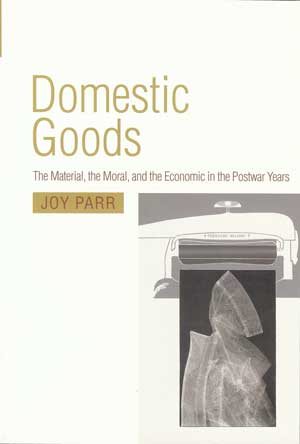Domestic Goods: the Material, the Moral and the Economic in the Postwar Years

Visions of life in the 1950s often spring from the United States: supermarkets, freeways, huge gleaming cars, bright new appliances, automated households. Historian Joy Parr looks beyond the generalizations about the indulgence of this era to find a specifically Canadian consumer culture. Focusing on the records left by consumer groups and manufacturers, and relying on interviews and letters from many Canadian women who had set up household in the decade after the war, she reveals exactly how and why Canadian homemakers distinguished themselves from the consumer frenzy of their southern neighbours.
Domestic Goods focuses primarily on the design, production, promotion, and consumption of furniture and appliances. For Parr, such a focus demands an analysis of the intertwining of the political, economic, and aesthetic. Parr examines how the shortage of appliances in the early postwar years was a direct result of government reconstruction policy, and how the international style of ‘high modernism’ reflected the postwar dream of free trade. But while manufacturers devised new plans for the consumer, depression-era frugality and a conscious setting of priorities within the family led potential customers to evade and rework what was offered them, eventually influencing the kinds of goods created.
This book addresses questions such as, who designed furniture and appliances, and how were these designs arrived at? What was the role of consumer groups in influencing manufacturers and government policy? Why did women prefer their old wringer washers for over a decade after the automatic washer was brought in? In finding the answers the author celebrates and ultimately suggests reclaiming a particularly Canadian way of consuming.
Reviews
This study breaks new ground. Parr’s analysis of domestic goods provides insights into the material, the economic, and the psychological in the postwar years and stimulates us to discover more about the artifacts, assumptions, and attitudes involved in household production and consumption.
Thierry Ruddel, Social History
Perhaps the single greatest strength of Domestic Goods is its multiple layers of investigation, each serving to reinforce and reverberate with each other. The three differentiated parts of the book — devoted to political economy, design, and household choices, respectively — bring together a variety of methodological approaches, cross disciplines, and venture out to juxtapose experiences elsewhere.
Rhona Richman Kenneally, Concordia University
Purchase
University of Toronto Press: https://utorontopress.com/ca/domestic-goods-1
Amazon: https://www.amazon.ca/Domestic-Goods-Joy-Parr/dp/0802079474/
Chapters Indigo: https://www.chapters.indigo.ca/en-ca/books/domestic-goods/9781487598112-item.html

